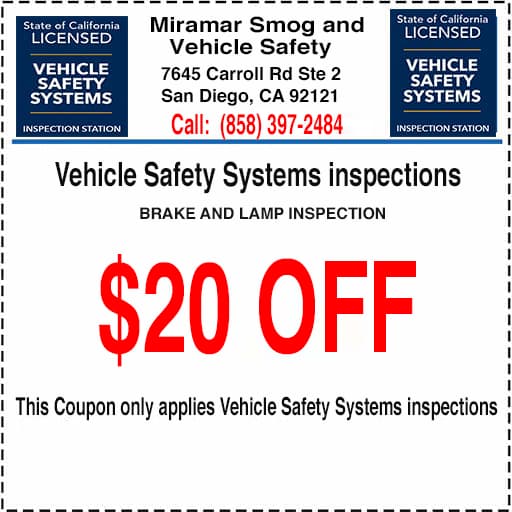Vehicle safety systems inspections San diego
Vehicle safety systems inspections San diego Near Me
Vehicle safety systems inspections
Vehicle safety systems inspection stations provide comprehensive inspections of vehicle safety systems. Technicians licensed to verify safety systems perform the inspections. The technician enters inspection results into the BAR Safety Inspection System (BAR-SIS). The BAR-SIS issues an electronic certificate of compliance if the vehicle passes. The vehicle owner can then register the vehicle with DMV and return it to the road.
Vehicle Safety Systems Inspections are a comprehensive safety check introduced by the California Bureau of Automotive Repair (BAR) to ensure vehicles, especially those with salvage titles, are safe to drive on California roads. Launched under Assembly Bill 471, this program replaces the older brake and lamp inspections with a broader assessment that covers critical safety components like brakes, lights, steering, suspension, and more. Starting June 27, 2024, licensed technicians at certified stations use the BAR Safety Inspection System (BAR-SIS) to perform these inspections and issue electronic certificates of compliance if the vehicle passes. This certificate is required for DMV registration, helping to get repaired or salvaged vehicles back on the road legally and safely.
The program aims to enhance road safety by setting clear standards, requiring specific equipment and training for technicians, and transitioning away from outdated paper-based certificates (which ended with the brake and lamp programs on September 27, 2024). Stations must meet BAR’s equipment and procedural guidelines, and consumers can learn more about inspection results, safety recalls, and registration processes through the BAR website.
- What is a vehicle safety systems inspection?A vehicle safety systems inspection is a thorough examination of a vehicle’s critical safety components to ensure they are functioning properly and meet regulatory safety standards. This includes brakes, lights, seatbelts, airbags, steering and suspension, tires, mirrors, windshield wipers, horns, fuel and exhaust systems, and onboard diagnostic (OBD) systems, where applicable.
- When is a safety systems inspection required?When registering a vehicle that has undergone significant repairs, especially to safety-related parts.After an accident or collision to verify that safety systems are intact.As part of routine maintenance or state-mandated periodic inspections.When required by the Department of Motor Vehicles (DMV) or regulatory authorities.
- What components are typically inspected?Braking systems (pads, discs, ABS functionality).Lighting and electrical systems (headlights, brake lights, turn signals).Seat belts and restraint systems.Airbags and supplemental restraint systems.Steering and suspension systems.Tires and wheels.Mirrors and glazing (windows, windshield).Windshield wipers and washers.Horns and warning devices.Fuel and exhaust systems.Speedometer and odometer functionality.Onboard diagnostics (OBD) for vehicles from 2000 and newer (except certain exceptions like motorcycles, electric vehicles, and heavy trucks).
- How long does the inspection take?Typically, a safety systems inspection takes between 30 minutes to 1 hour, depending on the vehicle type and complexity. Larger or more complex vehicles may require additional time.
- What happens if my vehicle fails the inspection?If defects or safety issues are found, a detailed report is provided. Repairs must be made before the vehicle can pass. After repairs, a re-inspection is then performed to verify compliance. Some jurisdictions offer a free re-test within a certain period (e.g., 20 days).
- What is the difference between the older brake and lamp inspections and the newer comprehensive Vehicle Safety Systems Inspection (VSSI)?The VSSI is a more extensive evaluation covering multiple safety systems beyond just brakes and lamps. It requires advanced equipment, trained technicians, and includes checks on steering, suspension, seat belts, airbags, and more. This expanded scope results in longer inspections and higher costs but improves overall vehicle safety.
- Are there exemptions or special cases?Some vehicles, such as electric vehicles, motorcycles, heavy trucks, and trailers, may be exempt from certain parts of the inspection (e.g., OBD checks).Older vehicles or certain types may also be exempt, depending on state regulations.
- How do I prepare for a safety systems inspection?Ensure all vehicle systems (lights, seatbelts, brakes) are functioning properly.Provide access to the vehicle and all necessary keys or codes.Be prepared to discuss any recent repairs or known issues with the inspector.
- What documentation or certificates are issued?Upon passing, an electronic certificate of compliance is issued, which is required for vehicle registration renewal. The certificate fee varies by state (e.g., $7 in California).
- Where can I get a safety systems inspection?Inspections are conducted at licensed inspection stations with certified technicians. Some providers offer mobile inspections at your location for convenience.
- What are common issues found during inspections?Malfunctioning or missing seatbelts.Faulty or non-working lights.Brake system wear or failure.Tire tread below legal limits.Steering or suspension problems.Open safety recalls that need to be addressed before inspection.
- How often must safety inspections be done? Frequency varies by jurisdiction: Annually in many states (e.g., Pennsylvania, Massachusetts). Biennially or at registration renewal, in others. Some vehicles may have different schedules based on type.


